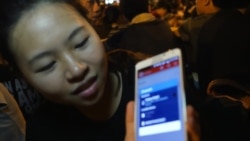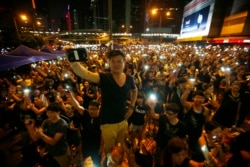Large-scale civic uprisings tend to spawn their own titles – Ukraine’s “Orange Revolution” for example, the “Velvet Revolution” in then-Czechoslovakia, or the newly minted “Umbrella Uprising” presently underway in Hong Kong.
These days, they also tend to launch the latest social network or mobile app seized on by protestors to help organize resistance and keep those in the streets as safe as possible.
Less than a week into the protests gripping Hong Kong in a showdown with Beijing over who will ultimately have a voice in the former British colony, that app has burst onto the scene.
It’s called “FireChat”, and while not exactly new, it has quickly become the must-have digital assistant for those fighting for democracy in one of the world’s most densely populated cities.
Sitting in a dark street surrounded by fellow protestors, Victoria Ng swipes at her mobile phone, reading FireChat messages. “Where can we park? Is there anything that we can provide?” she says, reading through the latest messages. “We need water, we need energy bars,” read the follow-up messages pouring in.
If you’re in Hong Kong, and you want to protest, it’s a good bet you’re using FireChat.
Old idea, new use
FireChat has been around for a little while, first released by parent company Open Garden in early 2014, but it’s based on a relatively old idea.
In short, mobile devices like phones or tablets mostly connect to the Internet via an intermediary, such as an ISP, WiFi, or the user’s mobile data service.
Thus a user who wants to share a tweet or a picture would send the data through one of those connections, where it would end up saved somewhere on a server – such as Facebook or Instagram – so it could then be shared.
One weakness of this tradition route is that in many countries those intermediaries can be filtered and controlled, preventing a user from reaching websites such as Instagram – as we saw just this week when authorities in Beijing blocked the photo-sharing service.
FireChat solves this problem by evading the Internet entirely. Instead of connecting other people together on distant servers, FireChat uses internal connections such as Bluetooth found on most mobile devices to connect near-by individuals in a sort of ad hoc private Intranet.
Once the app is downloaded (for free), FireChat uses Bluetooth and WiFi to “smell out” any other devices with Firechat running nearby.
Users can talk with one another on a variety of “chats” or topic threads, sharing information on any subject they feel like.
As more users enter the chats, the service creates what’s known as a “mesh network” – essentially a private, free-access chat room without any connection to the web.
This type of connection is nothing new; mobile phones and devices have been talking to each other for years via Bluetooth or other low-power radio services.
What FireChat does is turn the old idea of one-to-one mobile connections into a many-to-many service, allowing for free-flowing communications.
There are several advantages to these mesh networks.
First, in a situation where many mobile users are gathered in a small space, access to mobile data or WiFi service is often limited, leaving many users out in the cold.
With FireChat, you can by-pass those crowded connections completely. Additionally, as many Hong Kong users have discovered, FireChat can’t be blocked or filtered by external parties, so users are free to say what they wish.
However, that freedom should not be confused with security. Because anyone can join any FireChat, in situations of civic unrest it’s likely that government or other security personnel are also joining in and monitoring what’s being said.
If protestors are looking to coordinate protests, for example, those conversations are completely open for anyone to see.
Additionally, while this hasn’t yet been seen, the potential exists for malicious users to send false information, possibly leading to confusion or worse.
FireChat developer Open Garden has also taken pains to continually point out that its service is not anonymous, and that users should always join in discussions using pseudonyms to avoid being identified.
That’s a message Madeline Earp, research analyst with the ‘Freedom on the Net’ project run by Freedom House, also emphasizes.
“The security aspect is something that protestors need to be very aware of,” she said. “There are two sides to a protest: there are the people on the ground, and there are the police.
"Both sides are playing an intelligence game," she said. "So the more repressive the environment, the more your personal security as a protestor is going to be vulnerable.”
Beyond FireChat’s limitations, there’s another cyber-risk apparently floating around Hong Kong.
Madeline Earp notes several news reports of an app called “Code4HK” that’s actually malware, aimed at infecting protestors phones in Hong Kong. Code4HK bills itself as an aid to Occupy Central, but is actually spyware from an unknown source.
“I think what it speaks to is that people on the ground are looking for digital resources to support this protest,” she said. “And so while apps are a great resource, they’re at their most effective when they’re built on trusted relationships.”
Different story on mainland
While Hong Kong has among the freest and fastest Internet and mobile data access anywhere, it’s a very different story just a few miles away on the mainland.
Not long after first connecting to the Internet in 1994, officials in Beijing soon realized the potential destabilizing nature of the web and in 1997 began constructing the “Golden Shield”, known colloquially as the Great Firewall of China.
These days it’s a fair bet that China has the most pervasive and sophisticated web censorship apparatus in the world.
Thus it’s no surprise that in the wake of the on-going protests, authorities have moved swiftly to limit, as best they can, access to Chinese citizens looking to download FireChat. Open Garden estimates traffic from the mainland has suddenly fallen off by two-thirds or greater.
Moreover, China has moved to further bolster its aggressive blocking of websites that began sometime this summer.
This week’s total block of Instagram is just the latest example.
The website GreatFire.org, which monitors Chinese censorship, began tracking in June stepped up efforts to block access from China to a host of websites wholesale, rather than their usual habit of just limiting specific pages or posts.
That’s a pattern seen specifically at VOA, when sometime around mid-July, traffic from China to the VOA English website suddenly crashed from hundreds of thousands of hits to a negligible trickle and has yet to recover.
Curiously, while Beijing continues to throttle access to VOA’s Mandarin and Cantonese websites, the data suggest they may not be blocking access as vigorously as with VOA English.
Traditionally during times of unrest, web circumvention use and downloads spike upward; witness surges of circumvention use during the anti-Putin protests in Russia and the so-called Arab Spring of 2011. However that doesn’t appear to be happening this time in mainland China.
Karen Reilly with the circumvention Tor project told VOA “There is nothing in metrics to show a spike, though bridge use is still difficult to count,” – bridge use referring to access points, or ‘nodes’ into the Tor circumvention network that aren’t listed in any directories, thus further obscuring where traffic is being routed.
‘Charlie Smith’, the pseudonymous co-founder of the website GreatFire.org, also told VOA via email he has not seen a significant uptick in Tor or other circumvention usage in China.
But he said via email that “Tor is not a perfect solution in China.”
VOA has reached out to two other popular circumvention networks among Chinese nationals, Freegate and UltraSurf, but has not yet received specific response as to their recent usage in China.
Smith confirmed that authorities in Beijing have significantly stepped up efforts to block any online information about Hong Kong from leaking into mainland China.
“There is increased censorship of the Hong Kong posts for a number of reasons - it has been a significant demonstration; violence was used by the police to disrupt the protests,” Smith said.
In addition to trying to block some sites, Chinese authorities also appear to be trying to manipulate the online discussions and what passes for “news” from Hong Kong.
“We’ve heard reports, for example, there are some state media outlets describing the protests as being supportive of the Chinese government, and of course they’re the opposite,” Earp said.
That’s confirmed by VOA Cantonese broadcaster Raymond Lam, who says online blog posts and comments coming from the mainland are trying to cast the Occupy Central protestors as either pro-Beijing, or groups affiliated with terrorists.
“It’s completely laughable to people in Hong Kong what they’re trying to say about the protests,” he said, but cautions that “while some in Beijing may see through that, it’s much less clear there.”
Democracy online
So, just how popular is FireChat in Hong Kong these days?
Consider this: the number of downloads of FireGate have surged in the last week alone from approximately 50,000 overall to over 500,000 on the Google Play store.
It’s currently one of the most popular apps in the iTunes store, and Open Garden says there were more than 100,000 downloads in a single 24-hour period on the island of Hong Kong alone.
“All hail wifi-less app FireChat for creating massive bluetooth networks for #occupycentral protests,” tweeted independent journalist Ivan Broadhead, “operational even if gov blocks the Web.”
While apps like FireChat are clearly getting a sudden boost thanks to the Occupy Central protests in Hong Kong, it’s still worth noting that nothing is perfect.
“Again, FireChat, like many apps, don’t really provide a lot of security,” cautioned Freedom House’s Earp. “Police are going to be looking for any opportunity they have to watch how people are communicating, where they’re going, and trying to anticipate and curb the movement.”
In the end, however, Internet freedom activists and researchers like Earp see what’s happening on the ground in Hong Kong as more than just displeasure about Beijing’s insistence on vetting political candidates for office.
“It’s a pro-democracy protest at heart, but I do think Internet freedom is an integral part of that,” she says. “People in Hong Kong see how different the Internet is in the mainland. When Internet freedom gets eroded, democracy gets eroded.”
“What you’re seeing in Hong Kong is people making active use of digital tools like apps to protect themselves from that erosion.”
VOA's Brian Padden also contributed to this report from Hong Kong.












